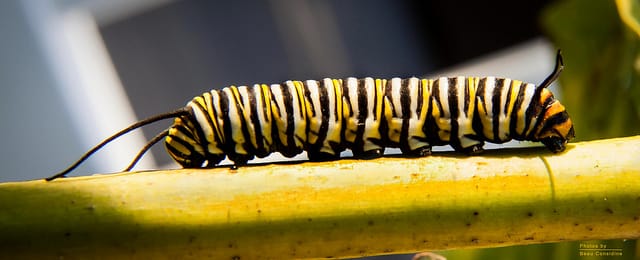MPR News
by Dan Gunderson
New, local research provides some of the first evidence that a popular group of insecticides might be killing young monarch butterflies.
The milkweed plants the butterflies need to survive may also hold neonicotinoid from nearby plants, making the milkweed toxic to monarchs.
University of Minnesota entomologist Vera Krischik fed butterflies milkweed plants treated with the amount of the insecticide Imidacloprid that might be found on backyard plants. Adult monarchs and painted lady butterflies were not affected. It appears the adults have the ability to detoxify, she said.
 Source: Beau Considine
Source: Beau Considine
“But then we were very surprised that it had a very big impact on the larvae,” Krischik said. “The larvae of both species of butterflies died.”
The tiny, just hatched larvae grow into the caterpillar you might see on a milkweed where they feed for a couple of weeks. During the study, larvae fed on treated plants for seven days.
“For the monarch, nobody was left that were feeding on the treated plants,” said Krischik, whose research has been accepted for publication by a scientific journal. “For the painted lady (butterflies), there were a few scattered larvae that made it to the end of their feeding period.”
Krischik says her research shows a potential — and she emphasizes potential — risk to monarchs when neonicotinoids are used in backyard plants near milkweed plants. She did not look at the impact of much lower insecticide rates used in farm fields.
“I would say if you’re using it in your back yard and you’re applying this to a rosebush right next to the milkweed, the risk is high,” she said.
Monarchs need milkweed. It’s their very first meal. Adult butterflies lay their eggs on the plant and when the larvae hatch, the caterpillars feed on the leaves for about two weeks.
Neonicotinoids are the most commonly used insecticide in the world. They are used on a range of garden plants, from roses to annual bedding plants. They’re absorbed by plants, so when a pest takes a bite of a leaf, it also gets a dose of insecticide. When they are applied to seeds or soil they are taken up by the plants along with nutrients.
The insecticide is in leaves, flowers and pollen. But it can also move through soil water or air to nearby plants, like milkweed. A Minnesota law passed last year requires labeling so consumers know if plants they buy are treated.
Krischik has previously documented the danger to bees feeding on flowers of plants treated with neonicotinoid insecticide. She’s also examined the effects of Imidacloprid on four species of lady beetles and found feeding on treated plants significantly reduced the survival of three of the four species.
While her monarch work focused on the insecticide’s exposure to backyard milkweed, researchers looking into insecticide use on farm fields are raising similar concerns. More than 90 percent of corn fields are treated with neonicotinoids. A large percentage of other crops like soybeans and sunflowers are also treated with the systemic insecticide.
Jacob Pecenka, a graduate student working with USDA scientist Jonathan Lundgren in Brookings, South Dakota, exposed monarch butterflies to the neonicotinoid insecticide Clothianidin in the lab, and they sampled insecticide levels in wild milkweed plants.
“We found that throughout the summer there was traceable amounts of the neonicotinoids in the milkweed plants,” Pecenka said. “So these caterpillars are getting exposed to it their entire lifetime.”
They found the insecticide levels in milkweed actually increased through June and July. That’s far longer than the 36 hours Lundgren exposed monarchs to the chemical in the lab.
“Having that exposure in the middle of the summer was a surprise to us,” Lundgren said. “That has really important implications for the risk assessment equation here. That exposure level is really important, and the duration of that exposure.”
The South Dakota research found that in a 36-hour exposure, neonicotinoid rates that killed monarch larvae were higher than would typically be found in field plants.
But they found at rates commonly used in farm field plants, the young monarchs growth was significantly stunted. A number of scientific studies show smaller caterpillars are less likely to survive and become butterflies.
It’s clear monarch populations are affected by neonicotinoid insecticides and more research is needed, said Lundgren, adding that there’s a compelling reason to take a closer look.
“Much of the habitat that’s left for the milkweed is in close proximity to agricultural fields,” he said. “So the monarchs are being forced into close proximity to these corn fields.”

